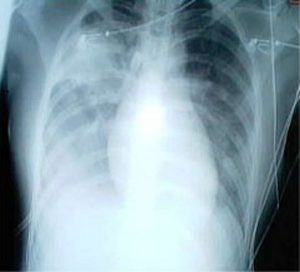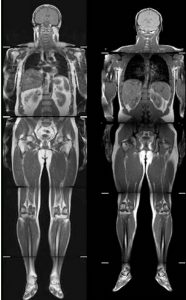Ideal Body Weight
What is Ideal Body Weight (IBW)? Essentially, every body has a set weight that reflects the size of their vital organs, based on their sex and height. IBW is not about a number on a scale or body morphology; it is a unit of measurement that is used to describe the organs in the body. Do not get caught up in the “weight” term—we use IBW to ventilate properly based on the size of the patient’s lungs.
Historically, clinicians used to ventilate with large volumes (>600 ml) and slow RR (10-12 bpm). This style of ventilation resulted in significant number of patients developing lung damage after mechanical ventilation for a few days. This damage was referred to as Ventilator Induced Lung Injury (VILI), and it sometimes resulted in an inflammatory process often referred to as Acute Respiratory Distress Syndrome (ARDS).

ARDS is a complex pathology that is recognized as diffuse bilaterally inflammation and damage to the lungs. It is usually identified on a chest x-ray after other pathophysiologies are ruled out. It can be caused by other processes in addition to VILI. These patients can become very sick and difficult to ventilate. If you would like some basic knowledge regarding ARDS, refer to these two links for a brief overview (the first link is more basic, and the second link provides more advanced information):
When it was identified that mechanical ventilation was seeming to cause bilateral damage to the lungs, multiple studies were carried out to determine if the settings on the ventilator were contributing to this. The conclusions were very clear that using large tidal volumes directly related to increased incidence of VILI by causing barotrauma (too much pressure in the alveoli) and volutrauma (too much volume in the alveoli). Health care providers were directly harming their patients with this high volume/low RR ventilation strategy.
Object Lesson
A weight-based approach to choosing tidal volumes started to be used. The smaller the patient, the smaller the tidal volumes and the larger the patient, the larger the tidal volumes. It was still common practice to assume patients with a higher weight required a larger volume to satisfy their ventilation needs (O2 in and CO2 out) because they had more habitus, meaning more cells in the body creating CO2 and needing oxygen to function. After bariatric patients were getting VILI at a higher incidence when the larger tidal volumes were used, further investigation revealed that the size of the lungs do not alter based on body weight of the patient. A person’s lung size is based on skeletal structure, which means the only relevant variables are sex and height. By ventilating heavier patients with larger volumes, clinicians were overinflating the alveoli in the lungs and causing barotrauma and volutrauma, leading to VILI.
Fun fact: If you see a full body CT scan or MRI of a bariatric patient, this concept is clear. Regardless of body habitus, a bariatric patient’s lungs are not larger than another patient that is the same sex and height. The size of the lungs does not change based on the body weight of the patient.

To fix this problem once and for all, ventilation is now completely based on Ideal Body Weight (IBW). IBW is calculated based on a patient’s sex and height to ensure the weight used to estimate the tidal volumes is correct based on what the patient should be getting. When setting up a ventilator for an adult patient, the only calculation you will have to do is determine their ideal body weight and then use that weight to choose a safe tidal volume for your patient.
Then, IBW depends on the sex of the patient. Here are the formulas for males and females:
| Sex | IBW formula (adults only) |
|---|---|
| Male | IBW (kg) = 50 + 2.3 (height in inches – 60)
or IBW kg) = 50 + 0.91 (height in centimeters – 152.4) |
| Female | IBW (kg) = 45.5 + 2.3 (height in inches – 60)
or IBW (kg) = 45.5 + 0.91 (height in centimeters – 152.4) |
Important note: For an adult patient, the minimum ideal body weight (kg) you will use is the constant at the beginning of the equation. If you end up with a zero or negative number in the bracket, do not continue with this formula: just use 50 kg for males or 45.5 kg for females—which are the minimum sizes for adult lungs.
RRT Hack: If you know a patient’s height in “feet and inches,” instead of converting this number to inches, you can save yourself a step. 60 inches is 5 feet tall. You are “minusing” 5 feet from their height in the formula, so a handy shortcut is to just write how many inches tall they are above 5 feet in that bracket (e.g., if a person is 5 foot 6 inches, you would just use the number 6 in brackets, which you will then multiply by 2.3 and add to the base number).
Let’s do a few calculations together!
Patient A | A male who is 6’2” (74 inches tall)
IBW (kg) = 50 + 2.3(74-60)
IBW (kg) = 50 + 2.3(14)
IBW (kg) = 50 + 32.2
IBW (kg) = 82.2 kg
Now, let’s try using the shortcut described above. You know they are 6’2” so this is 1 foot (12 inches) plus 2 inches above 5 feet tall (60 inches) = 14 inches. Just plug 14 into the bracket. Look! You are already on step 2 of the formula! Mental math skips the step of having to figure out how many inches if you do not have it handy.
Patient B | A female who is 5’3”
IBW (kg) = 45.5 + 2.3(63-60)
IBW (kg) = 45.5 + 2.3(3)
IBW (kg) = 45.5 + 6.9
IBW (kg) = 52.4 kg
Now, let’s use the shortcut… the patient is 3 inches taller than 5 feet. We subtract 60 inches (5 feet) from their height to do the calculation. Therefore, we take how much taller she is above 5 feet, and that number of inches goes in the bracket. Therefore 3 goes in the bracket to multiply with 2.3 and then add to the female constant of 45.5.
Patient C | A male who is 175 cm
IBW (kg) = 50 + 0.91(175 – 152.4)
IBW (kg) = 50 + 0.91(22.6)
IBW (kg) = 50 + 20.566
IBW (kg) = 70.566 kg
Because this formula uses centimeters instead of inches, the “shortcut” does not apply.
Media Attributions
- SARS_xray © Centers for Disease Control and Prevention is licensed under a Public Domain license
- Xrays © EL Thomas and JD Bell is licensed under a CC BY-SA (Attribution ShareAlike) license

